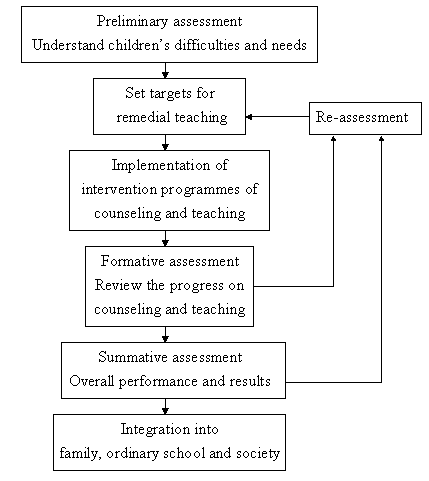Maladjusted children require the support of different disciplines to help them to integrate into mainstream schools and society. So the schools concerned need a structured assessment system for tapping continuous and up-to-date progress information on pupils' academic as well as personal and social development. It is important for all parties concerned because they can have a comprehensive picture of pupils' development and their immediate situations. With this knowledge, intervention plans can be worked out or adjusted according to the specific needs of pupils.
The purpose of assessment in school is to enhance children's adjustment in personal, family, school and other social aspects. At different stages, there are different targets to be assessed. Professionals have to design appropriate assessment contents according to the learning targets.
5.1.1Preliminary Assessment5.1.2This is to understand the difficulties encountered by children. Information collected includes their background, personal characteristics, usual ways in handling interpersonal relationship, their attainment, interest and attitude to learning. Based on this understanding, professionals can design targets of interventions more precisely and effectively in meeting children's needs.
Formative Assessment5.1.3Formative assessment refers to the ongoing assessment of pupils' learning and progress throughout the course and describe how pupils are working towards learning targets (General Introduction to Target Oriented Curriculum, Education Department, Hong Kong, 1994)
Professionals working for maladjusted children should provide appropriate interventions according to the targets set. Regular assessments are conducted to review children's progress and effectiveness of the intervention. Targets and interventions may be modified when necessary.
Summative AssessmentSummative assessment refers to the assessment of pupils' overall progress at important intervals, such as the end of a school term, a school year or a unit and is designed to provide a comprehensive, summary description of performance and progress in pupils' learning. (General Introduction to Target Oriented Curriculum, Education Department Hong Kong, 1994)
Adjustment difficulties are transient phenomena. The ultimate goal is to help children adjust and integrate into society. So summative assessment which involves the professionals concerned, pupils and their parents is important. If the targets are attained, children will be ready to integrate into family and society which include mainstream education, vocational training and open employment. If progress is behind schedule, children's needs should be reviewed and effective intervention be redesigned.
Characteristics of the assessment mechanism include the following:
(1) based on criterion referencing principles; (2) covers a wide range of appropriate assessment methods and reporting strategies which are planned before programme implementation; (3) includes objectively stated assessment criteria and activities for each learning target; (4) based on various forms of assessment activities including : practical tasks, observation of pupils' performance, oral interviews, discussion, checklists, skills or performance descriptions and projects;(5)
information to be reported objectively and in detail;
(6) effective and reliable; (7) with the understanding that, by only one shot of assessment, the complexity of pupils' performance in their academic work and personal and social development cannot be revealed.

(1) Content to be assessed
It is important to identify pupils'baselines and their progress in different subjects. The content of assessment is suggested as follows:
(a) Experience in learning (b) Abilities in learning (c) Interests in learning (d) Existing level of achievement (2) Methods of assessment
Assessment should be criterion referencing, diversified, comprehensive and objective. The following methods may be included:
(a) Children's classwork and homework (b)
(c)
Class tests
(d)
Informal or formal observation of various aspects of pupils' performance
(e)
Oral interview
(f)
Discussion
(g) Reviewing children's record of learning
(h) (i) 5.4.2 Personal and Social Development
(1) Content to be assessed
It aims at understanding the experiences and progress in the following aspects of personal and social development among children:
(a) Knowledge of
-- oneself, one's family, school, immediate surrounding, community and society;
-- personal hygiene and health;
-- the importance of social skills;
-- the meaning of work;
-- the importance of team spirit and being co-operative.
(b) Attitudes and habits towards
-- oneself, one's family, school and social interaction;
-- personal hygiene and health;
-- work habit and attitude;
-- participation and actualization of team spirit;
-- human and natural environment.
(c) Skills in
-- social interaction;
-- self-care;
-- adjusting to society, managing stress and solving problems;
-- independent living and thinking skills;
-- expressing ideas and thoughts;
-- expressing emotions and feeling.
(2) Methods of assessment
(a) collection of reports from children, their parents and personnel from various disciplines for objective and comprehensive analysis; (b) systematic record of the performance of children in various settings from direct observation; (c) case conferences involving children, their parents and personnel from different disciplines for updated information and opinions; (d) individual interviews or use of various assessment tools by social workers, teachers and psychologists for more thorough understanding and analysis of children's problems. Generally speaking, maladjusted children have been growing up in complicated background. Through assessments on different aspects, people concerned can gain a better understanding of their characteristics and needs. Besides, children's behaviour and emotion are ever changing as they are easily influenced by various factors. For this reason, intervention should be readily modified according to these changes in order to reach the expected targets. Continuous assessment is essential to reveal these changes.